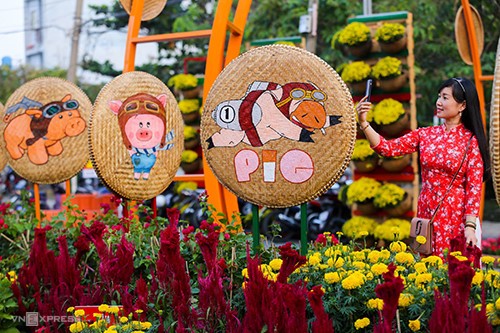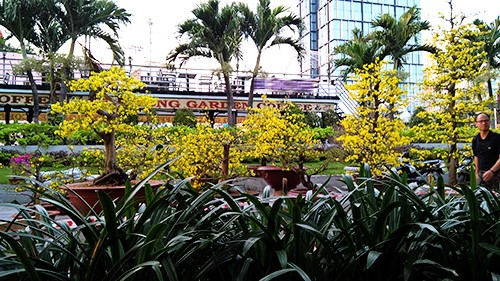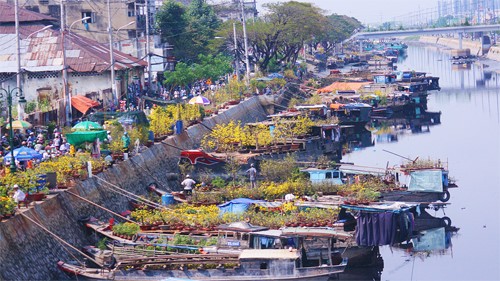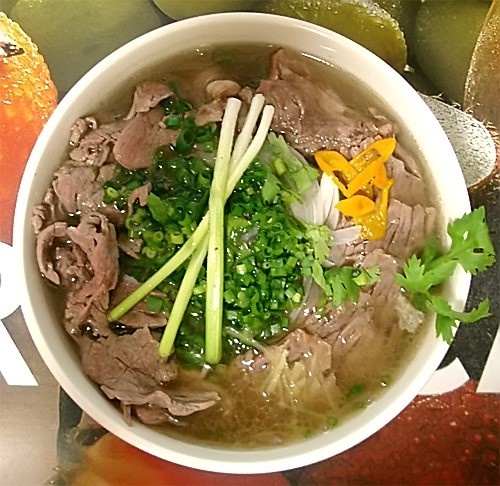A: This week many listeners sent us emails and letters confirming they have received VOV’s New Year gifts. Muralidhar M of India wrote: “I listen to the great programs broadcast by the Voice of Vietnam. I received the New Year gift from VOV: a VOV5 cap and a beautiful calendar. Thank you and wish you all a wonderful and happy New Year 2019.”
B: Jayanta Chakrabarty of India wrote: “I’m happy to acknowledge the receipt of the beautiful VOV5 New Year greetings card and a pocket calendar. Thank you for your kind gesture.”
 A flower street in Hiep Phuoc industrial park, Ho Chi Minh city, is set tp to welcome traditional lunar New Year A flower street in Hiep Phuoc industrial park, Ho Chi Minh city, is set tp to welcome traditional lunar New Year |
A: Abdul Mannan of Bangladesh, a regular listener of our Letter Box, would like to know about the biggest festival in Vietnamese culture. He asked: “What kind of entertainment activities are there? What kind of food would be served at the festival?”
B: Like people in many other Asian countries, Vietnamese people have two New Year celebrations but Tet or the traditional lunar New Year is more important. It is the biggest festival of the year for the Vietnamese.
A: Across Vietnam, during this time families reunite and honour their ancestors, while praying for luck, prosperity and health in the new year. The public holiday may only run for one week, but in reality, Tết celebrations last much longer.
B: Tết marks the first day of the Lunar New Year, and the beginning of spring in the north of Vietnam. The holiday traces back to the early days of Vietnamese settlements in the Red River Delta, when Tết meant a new cycle of wet rice cultivation. Today, the meaning of the holiday runs much deeper than its farming roots: Vietnamese culture emphasizes the importance of a fresh start, surrounded by family and loved ones.
A: Throughout Vietnam, preparations for Tết begin weeks in advance in the form of cleaning, decorating, and sprucing up local environs for the holiday tradition. Vietnamese people shop for new clothes, get haircuts, cook special dishes, buy flowers, and even wash their motorcycles.
B: Each home and office will be decorated with signs of “Happy New Year”, and kumquat trees or peach blossoms will be set in a place of honor. Streets burst with color as these trees are transported on the backs of motorbikes. In anticipation of the long holiday, a festive spirit takes hold of the country.
 3/9 Park in district 1, Ho Chi Minh City hosts a Tet flower market annually 3/9 Park in district 1, Ho Chi Minh City hosts a Tet flower market annually |
A: In the days before Tết, markets and streets are jam-packed with shoppers. Busy housewives pick up foil, paper garlands, and auspicious red and gold decorations shaped like fish, coins, and blossoms.
B: Food -- especially the traditional bánh chưng (square sticky rice cake is important for the celebrations.
A: Making Chung cake for the Lunar New Year is an age-old tradition of the Vietnamese people. Chung cakes are considered meaningful gifts and an indispensable offering on ancestral altars during Vietnam’s biggest festival of the year.
B: Chung cake consists of sticky rice, pork and green bean paste, with all ingredients wrapped inside a leaf called Dzong, which is similar to banana leaves. The round shape symbolizes the earth, while the ingredients represent plants, animals, and wet rice civilization.
 The flower market in Binh Dong Wharf located in district 8. The flower market in Binh Dong Wharf located in district 8. |
A: Nowadays, in some big cities, the business life of modern society prevents people from making the cake at home. However, the custom of worshiping ancestors with Chung cake never changes. It evinces the loyalty and deep gratitude the Vietnamese have for their ancestors.
B: A family reunion feast is served on the penultimate day of the year. On New Year’s Eve, most Vietnamese people stay at home for a family reunion party. Some go out to see a fireworks display at a public venue. When midnight comes everybody, whether at a big party or in the comfort of their home, wishes each other a Happy New Year.
A: During the first 3 days of the New Year, we visit relatives and friends to greet them in the New Year and wish them all manner of good fortune: happiness, health, prosperity, and success. We give lucky money to old people to wish them longevity, to children for good academic results, and adults for good business and prosperity. The money should be new and put in little red envelopes because red represents good luck.
B: Many traditional Tet practices such as family get-togethers, Tet food, Tet decorations, and Tet visits have been followed for hundreds of years. VOV’s features during Tet will cover Vietnam’s Tet in the past and present, traditional and modern customs, the older generation’s memories of Tet in years past, and the impressions of foreigners in Vietnam. So don’t miss any of these programs on VOV to enjoy the Vietnamese Tet atmosphere.
A: Next is an email from Sardar Munir Akhter of Pakistan: “Best wishes from Taxila Pakistan. I’m President of the Satora Listeners’ Club. We have 15 members and listen to your English Service program daily. Your programs are very informative and excellent. We have a question: what is the food that the Vietnamese like to eat the most?
 Pho- Vietnamese rice noodle soup with beef Pho- Vietnamese rice noodle soup with beef |
B: Food is one of Vietnam’s top attractions for foreigners. In Vietnam, we don’t identify one particular food as our traditional food because food varies by region throughout the country. Pho, Vietnam’s noodle soup might be the most popular. This simple staple consisting of broth, fresh rice noodle, and a sprinkling of herbs and either chicken or beef, features prominently in the local diet. It's cheap, tasty, and widely available.
A: A steaming bowl of pho noodle soup is not hard to find in Vietnam. Just like pad thai in Thailand, pho is Vietnam's unofficial national dish, exported with pride all over the world.
B: Pho consists of flat rice noodles in a light, meat-based broth. The dish is usually accompanied by basil, lime, chili, and other extras on the side so that diners can season the soup to their own taste. The contrasts of sweet, salty, spicy, and citrus make for a winning combination; pho usually becomes an instant favorite for anyone visiting Vietnam.
A: Previously, pho noodle soup was eaten by Vietnamese people for breakfast and sometimes lunch. Today, both locals and foreigners alike can be found hunched over steaming bowls of pho at street carts throughout the night.
A: Food is just of one of Vietnam’s many attractions. Visit Vietnam one day to explore more of the country’s culture, traditions, and landscapes.
B: For today’s show, we’d like to thank Siddhartha Bhatachrjee and Shyamal Jumar Banerjee of India, Richard Nowak of the US, and Richard Lemke of Canada for sending feedback on our broadcasts.
A: We’ll send you our QSL cards to confirm your reports. We welcome your feedback at English Service, VOVworld, Voice of Vietnam, 45 Ba Trieu Street, Hanoi, Vietnam. Our email address is englishsection@vov.org.vn. Thank you for listening to VOV on shortwave and following us online. Good bye until next time.